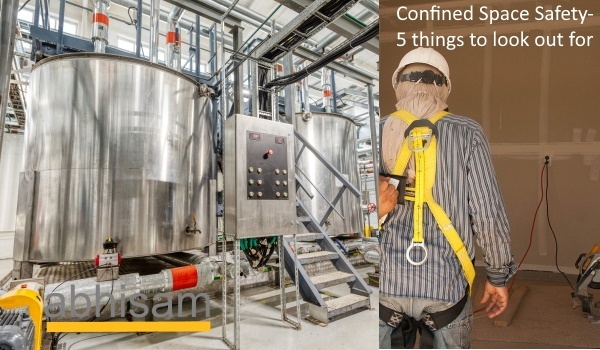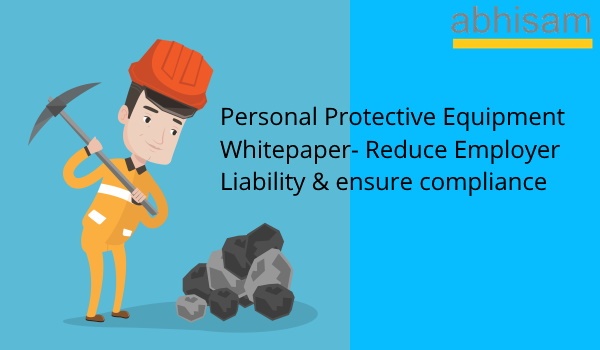Executive Summary
Personal Protective Equipment (PPE) is the last safe-guard against workplace hazards which may be physical, chemical, biological or radiation hazards.
At various stages of using PPEs, there are statutory requirements which need to be fulfilled in toto. One of these is making sure that proper PPE training is provided to employees. The employer who runs a production facility is under legal obligation to fulfill all legal requirements.
This White paper lists out many of the legal requirements and provides some of the action points which reduce liability on part of employers and also gives potential cost savings in terms of insurance premium.
Disclaimer: Nothing in this white paper can be construed as legal, safety or engineering advice. You should carry out your own due diligence to evaluate your options with regards to rules and regulations, laws that apply to your jurisdiction.
Background
In any manufacturing set-up, we encounter plant and machinery, energy sources, working people, material storage, effluents & waste products. The manufacturing site may be a chemical plant or mechanical workshop or pharmaceutical formulations or even a construction site.
Let us take an example of a chemical plant. There are safe-guards which are in place between the “process” and the “operator” These safe-guards are called “Layers of Protection”. The following diagram gives the pictorial presentation of the Layers of Protection. This concept is known as LOPA (Layer of Protection Analysis for short) and is not new. This diagram is also sometimes popularly referred to as an “Onion diagram” because of the way it looks.
However we have modified the commonly used LOPA diagram, to also include worker PPE as seen below.

The diagram shows that the “process” is at the center. The “design” layer is the first safeguard. The “Process Control System” is the second guard. The “Alarms and Operator Intervention is the next safeguard. A Safety Instrumented System, which takes the plant to a safe state, in case of abnormal behavior of plant becomes the next layer of protection. The relief systems such as safety relief valves, rupture discs/burst discs form the next protection layer. The workers who are in the field come into contact with abnormal releases of toxic chemicals or flammable materials. To protect field workers from such accidents, personal protective equipment (PPEs) are designed.
Thus the PPE is the last layer of protection that will prevent a worker from getting injured in case of a mishap.
Which is why employers need to pay adequate attention to the provision, usage and training of PPE to their workers.
The responsibility matrix in the life cycle of a PPE is given below.

For an excellent self-paced online training course in PPE, please take a look here.
You can deploy this course instantly to all your employees and also get records of their usage, test scores and other data in your own dashboard, helping you meet compliance as regards PPE training.

Statutory compliance authorities in different countries
OSHA in the United States
The US Occupational Safety and Health Administration (OSHA) is the regulatory authority in the US regarding workplace safety and regularly publishes guidelines and norms to be followed to ensure safety in workplaces.
The general requirements for the use of PPEs is given in the following link
https://www.osha.gov/laws-regs/regulations/standardnumber/1910/1910.132
The employer is responsible for
- Hazard assessment
- PPE selection
- PPE training
- PPE retraining
- PPE maintenance and disposal
2. HSE for the United Kingdom (UK)
Health and Safety Executive of the UK gives guidelines on usage of PPEs. The duties of employers concerning provision and use of personal protective equipment are given in the guidelines. The following link gives the details
http://www.hse.gov.uk/toolbox/ppe.htm
The guidelines talk about the following
- Risk reduction
- PPE selection
- PPE usage
- PPE training
Following statement is reproduced from the guideline to emphasize the point
“You must choose the equipment carefully and ensure employees are trained to use it properly, and know how to detect and report any faults”
The Personal Protective Equipment Regulations 2002 and the Personal Protective Equipment at Work Regulations 1992 (as amended) give the main requirements
http://www.hse.gov.uk/pUbns/priced/l25.pdf
http://www.legislation.gov.uk/uksi/2002/1144/contents/made
3. Government of India, Ministry of Labor and Employment
The Government of India has published a draft labor code regarding Occupational Safety, Health and working conditions on 23rd April 2018.
https://labour.gov.in/sites/default/files/Last_Date_Extended_for_OSH_Code_0.pdf
Section 14 details “the rights of employee” where all the information regarding the working conditions have to be provided by the employer
Section 23 details the “Responsibility of Employer for maintaining health and working conditions” where the obligations of employer are listed
Statutory bodies around the world follow similar guidelines and statutes. The common theme in the regulation is the “liability of employer”
Actual Cases
Based on this published data by OSHA, we will now look at three incidences of injuries due to non-usage of PPE, inadequate or improper PPEs
Case 1: Wilbur-Ellis Company LLC
Location: 2690 Highway 194, HART, TEXAS
Date: 13th March 2017
An employee was changing an anhydrous ammonia pump when some of the chemical splashed on him, resulting in burns to his hand, arm, neck, and chin. The pump was not locked out and no personal protective equipment was worn at the time
From this incident, we can say that in all probability, the Employee was not aware about usage of Personal protective equipment or not using it due to casual approach.
Case 2: Rollins, Inc.
Location: 524 Hillwood Circle, AUGUSTA, GEORGIA
Date: 15th March 2018
An employee was preparing to dig a sump underneath a residential home while wearing personal protective equipment when he suffered from heat exhaustion, requiring hospitalization
From the incidence, we can say that the employee was wearing the personal protective equipment but it may not be adequate or proper for usage which resulted in heat exhaustion
Case 3: Entegris, Inc.
Location: 3225 Dow Road, RUSSELLVILLE, ARKANSAS
Date: 12th April 2018
An employee was cleaning out a temperature port when heated carbon powder came out and sprayed his face, neck area, and right forearm. He suffered first degree burns to his chin and neck area and second degree burns to his right forearm, requiring hospitalization. Personal protective equipment was not worn at the time of the incident
From the incidence, we can say that the employee was unprepared for any kind of splash and did not protect himself.
From the above incidences, it is the responsibility of the employer to prove that proper PPE was provided and the employee received proper training for the usage of PPE when the enquiry takes place regarding employer role.
The incidences are published by OSHA as given in the following link
https://www.osha.gov/severeinjury/index.html
Learning from the three cases
- The employees were either working without proper PPEs or with inadequate PPEs.
- Incidences are completely preventable or at least the severity of injuries can be reduced with proper use of PPEs.
- Inadequate training of employees, leading to casual behavior with regards to personal protective equipment.
- It is the responsibility of the employer to prove that proper PPE was provided AND the employee received proper training for the usage of PPE when an inquiry takes place regarding the employer’s role in any unwanted incident/accident.
How do we prevent such mishaps?
The mishaps can be prevented by series of actions on the part of employers. The actions include the following
- Conduct a Hazard /Risk assessment.
- Provide properly designed personal protective equipment.
- Ensure employees are trained for their usage.
- Keep records of the training.
- Assess employees for their understanding of PPEs.
- Monitor & review progress periodically.
- Adequate supervision on the shop-floor for proper usage of PPEs.
Conclusion
Workplace injuries are preventable or their impact can be greatly reduced, with concerted efforts on the part of employers. The entire work force needs to get properly designed PPEs and they should also get adequate training for their usage on the shop-floor. Conducting frequent awareness training programs about personal protective equipment OR by enabling workers to access such training programs online, should drastically reduce or eliminate such accidents.
Remember again, each and every accident is preventable.
The following courses are designed to take care of employee training courses with respect to PPE compliance
https://prettygoodcourses.com/courses/personal-protective-equipment-ppe/
https://prettygoodcourses.com/courses/head-ppe/
https://prettygoodcourses.com/courses/eye-face-protection/
https://prettygoodcourses.com/courses/ear-protection/
https://prettygoodcourses.com/courses/respiratory-protection/
https://prettygoodcourses.com/courses/hand-protection/
Free Whitepaper on Occupational Safety & premium PPE Training Courses
Confined Space Safety - 5 things to watch out for

This free Confined Space Safety whitepaper helps you understand the 5 important things to look out for when working in confined spaces. It also provides you with a handy Confined Space Safety checklist
Personal Protective Equipment Training Online

For an excellent self-paced online training course in PPE, please take a look here.
You can deploy this course instantly to all your employees and also get records of their usage, test scores and other data in your own dashboard, helping you meet compliance as regards PPE training.
Contact Us by filling the form below OR call us OR email

